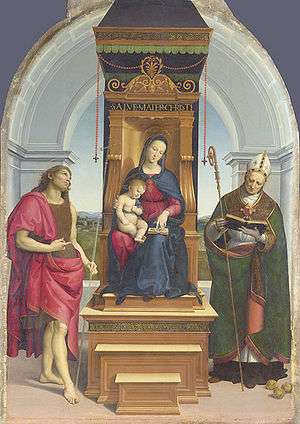Open Form


Open form is a term coined by Heinrich Wölfflin in 1915 to describe a characteristic of Baroque art opposed to the "closed form" of the Renaissance (Wölfflin 1915, chapter 3). Wölfflin tentatively offered several alternative pairs of terms, in particular "a-tectonic" and "tectonic" (also free/strict and irregular/regular), but settled on open/closed because, despite their undesirable ambiguity, they make a better distinction between the two styles precisely because of their generality. In an open form, which is characteristic of 17th-century painting, the style "everywhere points out beyond itself and purposely looks limitless", in contrast to the self-contained entity of a closed form, in which everything is "pointing everywhere back to itself" (Wölfflin 1950, 124). In general, the closed compositions of the 16th century are dominated by the vertical and horizontal, and by the opposition of these two dimensions. Seventeenth-century painters, by contrast, de-emphasize these oppositions so that, even when they are present, they lose their tectonic force. The diagonal, on the other hand, becomes the main device used to negate or obscure the rectangularity of the picture space (Wölfflin 1950, 125–26).
Although the term first occurred only in this book, the foundations for this concept had already been articulated by Wölfflin in 1888, in his earlier book Renaissance und Barock (Kaletha 2004, 121, n79). The closed/open pairing was one of five pairs of opposed categories to contrast the differences between the two periods. The others were the linear and the painterly, plane and depth, multiplicity and unity, and clearness and unclearness (Podro 2010).
The concept was soon adopted in other fields. Although in Wölfflin's opinion architecture could only be tectonic and therefore "closed" (Wölfflin 1950, 149), the notion of openness found its way into the theory of architecture by 1932, when Helmuth Plessner gave a lecture on modernist architecture in Germany to mark the twenty-fifth anniversary of the Deutscher Werkbund (Plessner [1932] 2001).
The essentially dynamic character of the film medium was seen as an essentially open form, in contrast to the closed form of selected "stills" from the same film, which could be appreciated for their pictorial composition (Read 1945, 142).
References
- Kaletha, Holger. 2004. "Decomposition of the Sound Continuum: Serialism and Development from a Genetic-Phenomenological Perspective", translated by Jerome Kohl. Perspectives of New Music 42, no. 1 (Winter, 2004): 84–128.
- Plessner, Helmuth. [1932] 2001. "Wiedergeburt der Form im technischen Zeitalter. Vortrag auf der 25-Jahr-Feier des Deutschen Werkbundes am 14. Oktober 1932". In Helmut Plessner, Politik—Anthopologie—Philosophie: Aufsätze und Vorträge, edited by Salvatore Giammusso and Hans-Ulrich Lessing, 71–86. Munich: . English translation by Jonathan Blower, as "Rebirth of Form in the Technical Age". Art in Translation 3, no. 1 (March 2011): 37–52.
- Podro, Michael. 2010. "Wölfflin, Heinrich". Grove Art Online (Accessed 28 September 2012).
- Read, Herbert Edward. 1945. A Coat of Many Colours: Occasional Essays. London: George Routledge & Son.
- Witcombe, Christopher L.C.E. 2013. "Art & Theory in Baroque Europe: Renaissance & Baroque Style (Heinrich Wölfflin)". Art History 344 (Fall). Sweet Briar, VA: Sweet Briar College (accessed 28 December 2015).
- Wölfflin, Heinrich. 1888. Renaissance und Barock: Eine Untersuchung über Wesen und Entstehung des Barockstils in Italien. Munich: Theodor Ackermann.
- Wölfflin, Heinrich. 1915. Kunstgeschichtliche Grundbegriffe: das Problem der Stilentwicklung in der neueren Kunst. Munich, F. Bruckmann. Fifth edition, Munich: Hugo Bruckmann Verlag, 1921.
- Wölfflin, Heinrich. 1950. Principles of Art History: The Problem of the Development of Style in Later Art, translated by Marie D. Hottinger. New York: Dover Publications.
Further reading
- Eco, Umberto. The Open Work, translated by Anna Cancogni, with an introduction by David Robey. Cambridge: Harvard University Press. ISBN 0-674-63975-8 (cloth); ISBN 0-674-63976-6 (pbk).